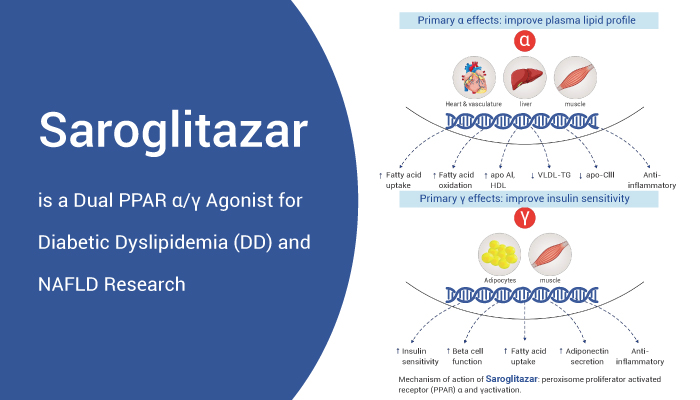PPAR is a ligand activated transcription factor of the nuclear hormone receptor superfamily. Meanwhile, it contains the following three subtypes: PPAR-α、 PPAR-γ And PPAR-β/δ. PPAR-α Activation can reduce triglyceride levels and participate in the regulation of energy homeostasis. Nonetheless, PPAR-α Plays a central role in lipid and lipoprotein metabolism, thereby reducing lipid abnormalities associated with metabolic syndrome. PPAR-γ Activation of insulin leads to increased insulin sensitivity and enhanced glucose metabolism. Moreover, PPAR-γ regulates adipocyte differentiation, FA storage and glucose metabolism. It is the target of anti-diabetes drugs. And PPAR-β/δ Activation enhances fatty acid metabolism.
Furthermore, the dyslipidemia in diabetes is relevant to insulin resistance, high plasma triglyceride level, low high-density lipoprotein cholesterol concentration, and so on. Non-alcoholic fatty liver disease (NAFLD) is a series of liver diseases including simple steatosis, non-alcoholic steatohepatitis, and more. Activated PPAR can also inhibit transcription through DNA independent protein-protein interactions with other transcription factors. In addition, PPAR-α and PPAR-γ are in human macrophages and exert anti-inflammatory effects. In fact, PPAR-α and PPAR-γ activators can increase apo-AI induced cholesterol efflux from normal macrophages. Therefore, the PPAR nuclear receptor family plays an important regulatory role in energy homeostasis and metabolic function. Today, we will introduce a dual PPAR α/γ agonist, Saroglitazar.
Saroglitazar is a Dual PPAR α/γ Agonist for Diabetic Dyslipidemia (DD) and NAFLD Research.
First of all, Saroglitazar is a PPAR agonist with predominant PPARα and moderate PPARγ activity. Saroglitazar has EC50 values of 0.65 pM and 3 nM in HepG2 cells, respectively.
In the second place, Saroglitazar causes dose-dependent reductions in serum triglycerides (TG), free fatty acids (FFA), and glucose. Importantly, the ED50 for these effects is 0.05, 0.19, and 0.19 mg/kg, respectively. Interestingly, Saroglitazar causes highly significant reduction in serum insulin and AUC-glucose following oral glucose administration at 1 mg/kg dose. Particularly, Saroglitazar causes TG lowering in Wistar rats and marmosets.
All in all, Saroglitazar is a dual PPAR α/γ agonist for diabetic dyslipidemia (DD) and NAFLD research.
References:
Jain MR, et al. Pharmacol Res Perspect. 2015 Jun;3(3):e00136.
